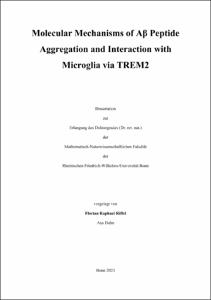Riffel, Florian Raphael: Molecular Mechanisms of Aβ Peptide Aggregation and Interaction with Microglia via TREM2. - Bonn, 2024. - Dissertation, Rheinische Friedrich-Wilhelms-Universität Bonn.
Online-Ausgabe in bonndoc: https://nbn-resolving.org/urn:nbn:de:hbz:5-74014
Online-Ausgabe in bonndoc: https://nbn-resolving.org/urn:nbn:de:hbz:5-74014
@phdthesis{handle:20.500.11811/11256,
urn: https://nbn-resolving.org/urn:nbn:de:hbz:5-74014,
author = {{Florian Raphael Riffel}},
title = {Molecular Mechanisms of Aβ Peptide Aggregation and Interaction with Microglia via TREM2},
school = {Rheinische Friedrich-Wilhelms-Universität Bonn},
year = 2024,
month = jan,
note = {Alzheimer’s disease (AD) is a progressive neurodegenerative disorder accompanied by a decline in cognitive functions. It is estimated that roughly 50 million people are currently suffering from AD, a number that is thought to triple within the next 20 years, thereby making AD the most common form of dementia. Neuropathological hallmarks of the disease are extracellular senile plaques, formed by neurotoxic amyloid beta peptides (Aβ), and neurofibrillary tangles containing hyperphosphorylated forms of tau. The importance of Aβ in AD pathogenesis is also reflected in the identification of certain rare mutations in the amyloid precursor protein (APP) as well as in proteins involved in its processing, namely presenilin-1 and 2 (PS1, PS2), which lead to early-onset familial AD (FAD). But since these only account for less than 5 % of all cases, a large ambiguity persists about the cause of the more common sporadic form of the disease (SAD). Interestingly, recent genome-wide association studies (GWAS) were able to identify a novel genetic risk factor encoding TREM2 that is involved in microglial function and inflammation. In addition to that, previous studies indicated that phosphorylation of Aβ might be another important factor contributing to SAD by changing the aggregation behaviour, conformation, and stability of Aβ peptides.
This study aimed, therefore, to develop a model to investigate the interaction between TREM2 and differentially modified Aβ species. This was achieved by the recombinant expression and purification of the ligand-binding domain of TREM2 coupled to the Fc region of the human IgG1 heavy chain (sTREM2-Fc).
By using this sTREM2-Fc, it was possible to show that TREM2 preferentially interacts with Aβ in its oligomeric rather than monomeric form. Furthermore, TREM2 showed increased binding to Aβ variants phosphorylated at serine 8 and serine 26 in comparison to its nonphosphorylated form. However, this interaction did not translate to increased activation of downstream signalling but did show a potential effect on Aβ aggregation and subsequent uptake in microglia. Thus, sTREM2-Fc presented as an appropriate model for studying interactions invitro, and the resulting observations could underline the importance of TREM2 in sensing and interacting with different Aβ species depending on phosphorylation and aggregation state.},
url = {https://hdl.handle.net/20.500.11811/11256}
}
urn: https://nbn-resolving.org/urn:nbn:de:hbz:5-74014,
author = {{Florian Raphael Riffel}},
title = {Molecular Mechanisms of Aβ Peptide Aggregation and Interaction with Microglia via TREM2},
school = {Rheinische Friedrich-Wilhelms-Universität Bonn},
year = 2024,
month = jan,
note = {Alzheimer’s disease (AD) is a progressive neurodegenerative disorder accompanied by a decline in cognitive functions. It is estimated that roughly 50 million people are currently suffering from AD, a number that is thought to triple within the next 20 years, thereby making AD the most common form of dementia. Neuropathological hallmarks of the disease are extracellular senile plaques, formed by neurotoxic amyloid beta peptides (Aβ), and neurofibrillary tangles containing hyperphosphorylated forms of tau. The importance of Aβ in AD pathogenesis is also reflected in the identification of certain rare mutations in the amyloid precursor protein (APP) as well as in proteins involved in its processing, namely presenilin-1 and 2 (PS1, PS2), which lead to early-onset familial AD (FAD). But since these only account for less than 5 % of all cases, a large ambiguity persists about the cause of the more common sporadic form of the disease (SAD). Interestingly, recent genome-wide association studies (GWAS) were able to identify a novel genetic risk factor encoding TREM2 that is involved in microglial function and inflammation. In addition to that, previous studies indicated that phosphorylation of Aβ might be another important factor contributing to SAD by changing the aggregation behaviour, conformation, and stability of Aβ peptides.
This study aimed, therefore, to develop a model to investigate the interaction between TREM2 and differentially modified Aβ species. This was achieved by the recombinant expression and purification of the ligand-binding domain of TREM2 coupled to the Fc region of the human IgG1 heavy chain (sTREM2-Fc).
By using this sTREM2-Fc, it was possible to show that TREM2 preferentially interacts with Aβ in its oligomeric rather than monomeric form. Furthermore, TREM2 showed increased binding to Aβ variants phosphorylated at serine 8 and serine 26 in comparison to its nonphosphorylated form. However, this interaction did not translate to increased activation of downstream signalling but did show a potential effect on Aβ aggregation and subsequent uptake in microglia. Thus, sTREM2-Fc presented as an appropriate model for studying interactions invitro, and the resulting observations could underline the importance of TREM2 in sensing and interacting with different Aβ species depending on phosphorylation and aggregation state.},
url = {https://hdl.handle.net/20.500.11811/11256}
}






